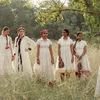How polyethene is being made into recyclable clothing
A team of scientists has discovered that single-use plastic can be made into recyclable fabric in a process that consumes less energy than cotton
Single-use plastics are among the worst things to have happened to our planet. However, the pariah of the packaging world may have found some redemption thanks to a team of scientists at the Massachusetts Institute of Technology, polyethylene can now be used to make breathable earth-friendly clothing.
The fashion industry a major environmental defaulter as it generates millions of tons of landfill waste, and manufacturing threads with nylon or polyester consumes massive amounts of water and generates 5–10 percent of global greenhouse gas emissions annually—and the fabrics are never recyclable.

Source: Shutterstock
Polyethylene itself is anti-wicking, and locks moisture which makes it suitable for packaging but in its basic form would lock sweat to the body rather than have it evaporate. The technique developed by the scientists has created an “efficient water wicking and fast-drying performance which, combined with their excellent stain resistance, offer promise in reducing energy and water consumption as well as the environmental footprint of textiles in their use phase.”
Furthermore, the processed polyethylene yarns can be coloured using eco-friendly techniques, thus eliminating the large amounts of toxic wastewater.
In a paper detailing the process Svetlana Boriskina, a research scientist in MIT’s Department of Mechanical Engineering said, “Once someone throws a plastic bag in the ocean, that’s a problem. But those bags could easily be recycled, and if you can make polyethylene into a sneaker or a hoodie, it would make economic sense to pick up these bags and recycle them.”
When polyethylene powder is subjected to existing industry-standard equipment, Boriskina and the team discovered that when the plastic is stretched into fibers, it becomes slightly oxidised. This oxidization gave the resulting yarn a thirst for water, therefore allowing it to draw sweat from the body efficiently.
The dyeing process consumed less energy than both polyester and natural cotton fabric. Additionally, as nothing sticks to polyethylene, the garments are stain-proof. The natural dyes make the clothes completely recyclable as well.
Edited by Diya Koshy George







